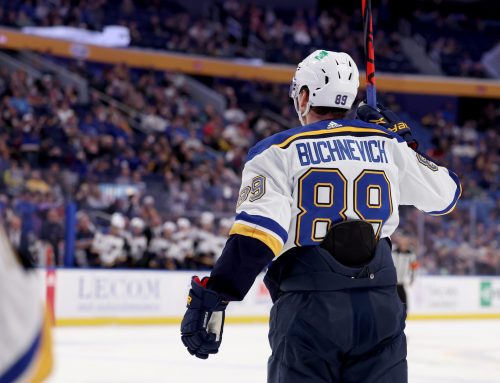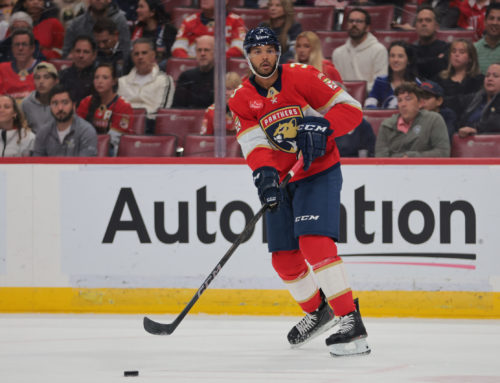
Can the Calgary Flames top trio of forwards repeat their performance from last year?
****
As always on Thursdays, be sure to swing by the Dobber Forums to have both fantasy and non-fantasy hockey questions answered. It is a good opportunity for readers to drop a line and get answers to questions that may require a bit more nuance than 140 characters on Twitter.
The questions can range from projections, to trade evaluations, to keeper selections, and anything else in between. Reminder: I’m not a prospect guy – I leave that to the proficient young talent evaluators here at Dobber – so beyond the notables like Connor McDavid and Jack Eichel, I won’t have an educated answer.
****
The 2015-2016 Dobber Hockey draft guide is available for the upcoming season! Be sure to check out the Dobber shop for a copy of your very own.
****
In going through stats from last year, I came across something I found pretty interesting: out of 121 forwards that had at least 1000 minutes at five-on-five last year, all of Johnny Gaudreau (29th), Sean Monahan (25th), and Jiri Hudler (3rd) finished in the top-30 in individual shooting percentage. The fact that they all finished in the top-30 isn’t absurd; it stands to reason that if a couple of the guys on a line are playing well, the whole line will play well together.
So the fact that they were all top-30 isn’t out of the ordinary. What has to be figured out is if they can all repeat that performance next year. In that sense, I thought I would look at two lines that performed similarly over the last couple of 82-game seasons, and what happened after.
Patrice Bergeron, Brad Marchand, and Reilly Smith (2013-2014)
This trio finished 39th, 15th, and 43rd respectively in shooting percentage that season at five-on-five, and the one outlier here was really Bergeron; his 30 goals in ’13-’14 was his highest mark since 2005-2006. Predictably, Bergeron’s five-on-five goal total fell (though only by three).
Marchand also saw his five-on-five goal total go down, but also by just three goals, despite his shooting percentage falling over 3.6-percent. This was because Marchand mitigated his drop in shooting percentage with a rise in shooting volume, taking just over 1.4 more shots on goal per 60 minutes.
Smith was the one who saw his goal total fall a lot, from 20 to 13 last season. The big reason here for that was a drop in power play goals, when he had six in 2013-2014 and just one (!) in 2014-2015. He actually had the same number of five-on-five goals.
Lesson: Smith’s goal total cratered largely due to a big drop in power play goals, even though he actually had more power play time per game last season than the one before. Unlike Marchand at five-on-five, Smith failed to mitigate a predictable drop in shooting percentage on the power play (he was 15/202 forwards at 5v4 in shooting percentage in 2013-2014) by upping his shot volume.
There is no real way to tell if/when a player will increase their individual shot volume other than progression as a young player. A giant red flag is shooting percentage, though, and if one is far too high – like Smith’s was – it’s a decent bet that the goals will tumble. That is why it’s important to look at both components of shooting percentage – 5v5 and 5v4 – as opposed to just the overall number.
David Desharnais, Erik Cole, and Max Pacioretty (2011-2012)
In respective order, that line finished 9th, 26th, and 50th in five-on-five shooting percentage that year. Oddly enough, Desharnais scored 10 goals at five-on-five that year, and eight in the lockout-shortened 2013 season, despite a small drop in shooting percentage. The reason, like Marchand, was that he had a big jump in his shooting rate – he went from 3.56 shots per 60 minutes in 2011-2012 to a four-year high of 5.29 in 2013. Desharnais actually followed up his career-high shooting percentage season with a career-high overall goals per game rate.
Erik Cole absolutely cratered after the 2011-2012 season. He scored 35 goals that year – 23 at five-on-five – and nine in 47 games the year after – eight of them at five-on-five (and after a trade to Dallas mid-season). Like Smith, he had a monster shooting percentage on the power play in 2011-2012; a career-high 26.32-percent. Predictably, that cratered the next year by well over half (10-percent even), and combined with a monster shooting rate, voilà, nine goals in 47 games. Again, the importance of looking at both components of shooting percentage is important here.
Pacioretty also saw a drop in goal scoring rate from 2011-2012 to 2013 even though he tried to mitigate that by taking nearly an extra shot per 60 minutes. With his five-on-five shooting percentage dropping 2.8-percent, he scored about 20-percent fewer goals than he would have if the 2013 season would have been a full year. That’s an extrapolated number, of course.
Lesson: First, those numbers have to be taken with a bit of a grain of salt, if only because the lockout-shortened season isn’t a good way to determine a player’s value. Maybe Pacioretty pops 16 goals in the extra possible 34 games and his final numbers look fine. We just can’t know.
What we did see was a couple of commonalities with the Bruins trio mentioned earlier: Cole’s and Smith’s (predictable) big drop in five-on-four shooting percentage had a big effect on their goal scoring rates, and inevitably their final totals. Meanwhile, Marchand and Desharnais were both able to mitigate their shooting percentage drops with added shot volume, and in Desharnais’ case, that boosted his scoring rate.
Back to Calgary
So what to make of the Flames’ top line?
Hudler having a high shooting percentage is nothing new – he led the league at five-on-five in this regard in 2011-2012. It should be noted, though, that after a big season in 2008-2009 (15.09-percent), that dropped to 8.45-percent. After his league-leading 21.3-percent rate in 2011-2012, it dropped to 14.29 percent the year after.
While Hudler could mitigate a likely drop in shooting rate next year with more shooting volume, his volume last year (5.48 per 60 minutes) wasn’t far off his career mark (5.67). I don’t think he jumps to seven or more shots per 60, so expecting close to a repeat of 31 goals is a lot to ask. If he can crack 25 next year, that should be a success.
Monahan had his overall shooting percentage increase from his first year (which was a stout 15.7-pecent to begin with) despite a drop at five-on-five largely because his 5v4 rate more than doubled from 10.53 to 24.32-percent. He was sixth out of 62 forwards in the NHL with over 200 minutes of 5v4 power play time.
I don’t expect a crater-like season from Monahan like Smith suffered after his 5v4 shooting percentage fell, but asking Monahan to improve on the 31 goals he scored last year seems to not be the smart bet. His one saving grace here might be a jump in volume, so I think projecting status quo rather than a goal bump seems prudent.
Of the three, I think it’s most reasonable to expect improvement from Gaudreau. While 24 goals in a rookie year is excellent, I think there’s room to improve to 30 next year. Neither his 5v5 rate (11.4-percent) nor his 5v4 rate (18.75-percent) were extreme. He was also a rookie so a higher shot volume rate is probably in order for him.
There is so much that can happen – what if the line is split up by November? – it’s really hard to project year-over-year goal scoring totals for entire lines. We have seen the red flags before in very proficient scoring lines, and there are flags here for both Monahan and Hudler, but for different reasons.
Of the three Flames members, Gaudreau will probably be the one drafted first (or he should be anyway). Even though the draft day price may be higher, I have the most confidence in him to improve his goal totals from last year, which means his price-point is probably the most enticing. Remember: if Hudler scores fewer goals, and Monahan does too, it'll impact the assist totals of everyone on the line.
I will say the one caveat here is that there’s a possibility that the shooting percentages stay high. The Toronto Maple Leafs for years were a team that were in top-10 in shooting percentage at 5v5, and it’s likely due to a high volume of rush shots (they were top-10 in shooting every season from 2010-2014). There’s a good bet that the Colorado Avalanche are falling into that category – they don’t generate a lot of shots but they do convert a high percentage of the ones they do get consistently; the Avalanche have been top-10 each of the last two seasons.
It is possible that the Flames fall into that Toronto/Colorado category of generating a lot of shots off the rush, and the people at Matchsticks and Gasoline have written about this recently. I’m just not willing to bet on that just yet. Note that this is for 5v5, so it pertains more to Hudler than Monahan.
For those needing a primer on what constitutes rush shots it’s available here from Hockey Analysis.
*Most stats presented taken from either Hockey Analysis or Hockey Reference





 FLA
FLA TOR
TOR CAR
CAR WPG
WPG DAL
DAL EDM
EDM WSH
WSH
